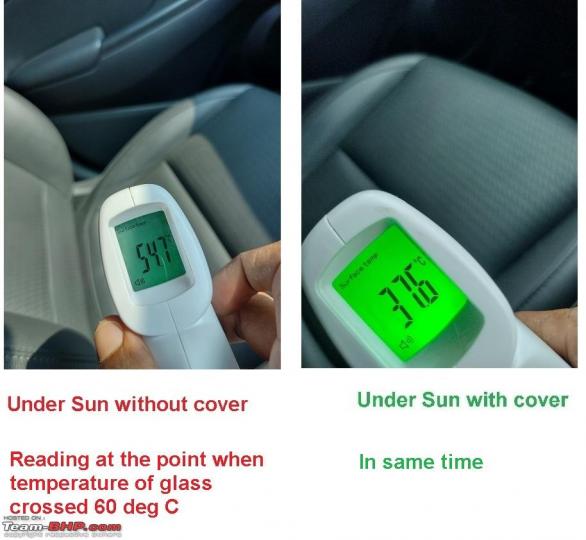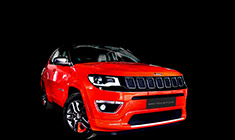News
Experiment: How much kWh does an AC consume to cool a parked EV
The savings definitely are not substantial around 0.7 to 1 KWh; it is more about the degree of comfort and degradation of the interiors that counts.
BHPian EV_Fan recently shared this with other enthusiasts.
Superheated glasshouses
The superheated interiors of the car glasshouse is a well known curse for us Indians.
Anyone could figure out that it was dangerously hot but i was curious on the numbers - how hot in Celsius, how much energy just to cool this to the acceptable levels.
While it was quite easy to figure out the interior temperatures, a simple no-contact thermometer to the task.
The energy used up for the cooling, was almost impossible to accurately figure out, atleast with the ICE’s. No consumption figures in liters of fuel or electrical units in KWh.
So could never figure it out, till we got the EV’s.
Almost all EV’s come with energy meters and this is what helped. The energy consumed in KWh’s by the AC was clearly indicated. (The reason why this post is in the electric cars section!)
So, down to the experiment.
This experimentation was all at Chengannur with a dry bulb temperature of around 35 deg Celsius but with humidity of 70% or higher, so that results in a heat index (felt air temperature) of around 50 deg Celsius. The body will sweat like anything but does not cool down.
Unfortunately the interiors of my car were dark grey with leather seats so you can imagine the discomfort (compared to, if it had lighter interiors with fabric seats).
To keep it simple, i will let the pictures do most of the talking


The temperature quickly overshot 60 degree Celsius, this was the temperature limit of the infrared thermometer i had, I do not know how high the temperature finally was!
At these temperatures, the car is intolerably hot. So it usually comes down to a full blast of AC, to make the car comfortable again.
Since that is quite inefficient for the experiment’s sake, I tried the slower and more time consuming process to see what would be the minimum energy required to cool the cabin down. Set temperature to 24 deg Celsius and fan at medium so that the entire cabin, including the rear seats get cooled).
The AC struggled to cool the cabin within 10 mins even while drawing more than 3 times the energy. Moreover the seats and the surface temperatures of the interior were still not comfortably cool. It took more than half an hour before the interior was cool enough and the AC load came down to around 0.6KW.
Compare this to, if the car was parked under shade – the AC starts off as low as 0.6KW and it's immediately cool.

Result: The savings definitely are not substantial around 0.7 to 1 KWh; it is more about the degree of comfort and degradation of the interiors that counts. Though for a mileage counter like me this another venue for savings.
So, as the designated driver, it was important for me to find a solution. After all it was my job, to cool down the car before others could comfortably enter.
A strong enough motivation, as it is not always easy to find a shaded spot - every time the car gets parked (although my brain is usually on overdrive when hunting for a parking spot).
The bonus, saving the precious unit of energy to cool down the superheated interiors.
Reflective half covers
And it was this hunt that finally led to something known as Reflective half covers. Initially it was used only at charging stops, but thanks to the heat wave we are facing nowadays, it just goes up every time the car is stopped for more than 30 mins.

This has now become my final solution after trying all the other options available on the market:

Sunshades (magnetic & suction cup ones): Cheap and mildly effective with vehicle running. Felt useless in parked vehicle
Reflective sunshades: - Could find only for front and while it was moderately effective, the glass still got hot (more than 60 degree Celsius) as this was placed inside. So when we get back in, the first few moments we can still feel the radiated heat.
And it is always a hassle if dashcam's and mobile mounts are on the dash.
Sun films: - Quite effective as long as the car is running and makes a world of a difference. But leave the car parked for more than 10-15 mins and it's as if the film never existed.
Reason - When the vehicle is running the glass gets cooled by air flow, the sun film does the job of limiting the incident Infrared from entering the cabin. But when the vehicle is stopped, within 10-15 minutes the glass heats up and in turn heats up the cabin.
I finally realized that all of these touted solutions, are inside the glass. So they cannot prevent the glass from heating up, which in turn heated up the cabin.(temperature above 60 degrees Celsius).
So, finally I tried carrying the bulky car cover:. Yes, i did carry it and tried putting it up under a blazing sun, in a burning parking lot, with folks watching me struggle, considering me to be nut case, which actually felt true at that moment ). It worked , the car was cooler. The unmanageable pain of putting it up, just made it impossible as the “on the go” solution.
And that’s how i ended up with these reflective half-cover’s
The most important points about these half - covers
- Best part, its compact and takes around a minute or two, to just throw this blanket over and strap it on to the vehicle(may not be as easy but got the jest of it after a few rounds).
- Temperature reduction’s almost like 20 degree Celsius.
- This material runs even cooler than the standard silver colour cover the car comes with.

Cons
- Not rain / waterproof
- Does not seem as thick/sturdy as the standard covers.
- Possibility of damage/tearing due to the stubby antenna
And as usual, i ended up even testing these covers.
Testing under the sun:
The comparison

It was suffocating hot without the cover.

The Hot seat – burning through even thick jeans.
While testing with cover i let the car stay out under the sun longer.

Result
It manages to keep the car “substantially cooler”.
There was another interesting observation , this reflective cover managed to keep the car almost 5 degree Celsius cooler than if the car was parked under shade without cover (thick tree canopy on one side and cool winds from the large irrigated paddy fields on the other side)

Continue reading BHPian EV_Fan's post for more insights and information.



















